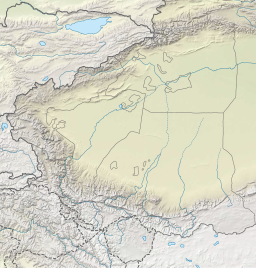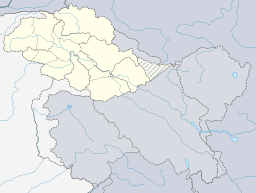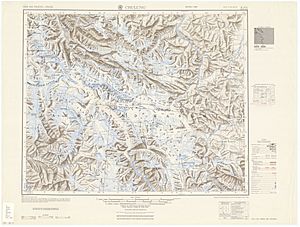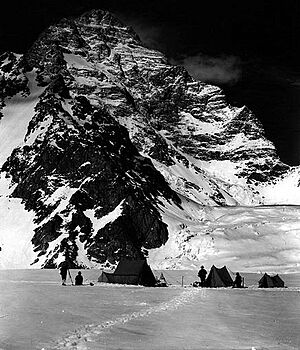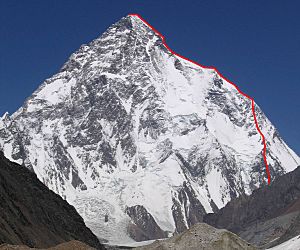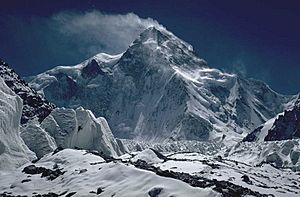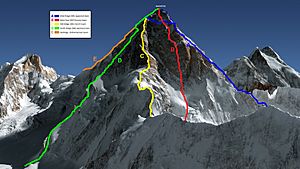K2 facts for kids
Quick facts for kids K2 |
|
|---|---|
| Highest point | |
| Elevation | Ranked 2nd |
| Prominence | Ranked 22nd |
| Geography | |
| Countries |
|
| Parent range | Karakoram |
| Climbing | |
| First ascent | 31 July 1954 Achille Compagnoni & Lino Lacedelli |
| Easiest route | Abruzzi Spur |
K2 is the second-highest mountain on Earth. It stands at 8,611 metres (28,251 ft) (about 28,251 feet) above sea level. Only Mount Everest is taller. K2 is part of the Karakoram mountain range. It is located on the border between Pakistan and China.
K2 is often called the Savage Mountain. This nickname came from a climber who said, "It's a savage mountain that tries to kill you." K2 is known for being very dangerous. For every four people who reach the top, about one person dies trying. It is considered the deadliest of the world's five highest mountains. Other nicknames include The King of Mountains and The Mountaineers' Mountain.
The first people to reach the summit of K2 were Italian climbers Lino Lacedelli and Achille Compagnoni. They made their climb on July 31, 1954. In January 2021, K2 became the last of the 14 highest mountains (called eight-thousanders) to be climbed in winter. A team of Nepalese climbers achieved this amazing feat.
K2 is a very difficult mountain to climb. Its weather is often harsh and cold. Most climbs happen in July and August, which are the warmest months. As of 2021, only 377 people have successfully climbed K2. Sadly, 91 people have died trying to reach its summit.
Contents
What's in a Name?
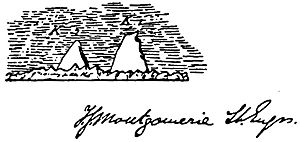
The name K2 comes from a survey done by the British in India. In 1856, a surveyor named Thomas George Montgomerie mapped the Karakoram range. He labeled the two most important peaks K1 and K2. The K stands for Karakoram.
The survey usually used local names for mountains. K1 was known as Masherbrum. But K2 did not seem to have a local name. This might be because it is very remote. It's hard to see K2 from nearby villages.
Some people suggested the name Chogori. This comes from two local words meaning "big mountain". But there isn't much proof that this name was widely used. Chinese authorities officially call the peak Qogir, which is based on Chogori.
Another suggested name was Mount Godwin-Austen. This was to honor Henry Godwin-Austen, an early explorer. But this name was not officially accepted. So, the surveyor's mark, K2, stuck. It is now the most common name for the mountain.
Where is K2 Located?
K2 is found in the northwestern part of the Karakoram Range. It sits in the Gilgit-Baltistan region of Pakistan and the Taxkorgan Tajik Autonomous County of Xinjiang, China. The mountain is surrounded by other large landforms. These include the Tarim basin to the north and the Lesser Himalayas to the south.
K2 is known for its impressive height above the valleys around it. It rises more than 3,000 metres (9,800 ft) (about 9,800 feet) from the glacier valleys at its base. It looks like a very steep pyramid. The north side is the steepest, climbing over 3,200 metres (10,500 ft) (about 10,500 feet) in a short distance.
In 1986, one expedition incorrectly measured K2 as taller than Mount Everest. This news spread widely. However, a corrected measurement in 1987 confirmed that Everest is indeed the tallest.
How Tall is K2?
The official height of K2 on maps and in encyclopedias is 8,611 metres (28,251 ft) (28,251 feet). In 2014, a team of Pakistani and Italian climbers measured K2 again. They used satellite technology. Their measurement found the height to be 8,609.02 metres (28,244.8 ft) (28,245.5 feet). This was very close to the original measurement.
Climbing K2: A History
Early Attempts to Reach the Summit
The first serious try to climb K2 happened in 1902. A team of climbers tried to go up the Northeast Ridge. Back then, there were no modern ways to travel in the area. It took two weeks just to get to the base of the mountain. The team faced sickness, bad weather, and disagreements. They reached about 6,525 metres (21,407 ft) (21,407 feet) but had to turn back.
In 1909, another expedition was led by Prince Luigi Amedeo, Duke of the Abruzzi. They reached about 6,250 metres (20,510 ft) (20,500 feet) on the Southeast Spur. This route is now called the Abruzzi Spur. It later became the most common climbing path. But at the time, the Duke thought K2 could never be climbed.
The next attempts were not until the late 1930s. In 1938, an American team explored the mountain. They decided the Abruzzi Spur was the best way. They reached about 8,000 metres (26,000 ft) (26,247 feet) before running out of supplies. In 1939, another American team got even closer. They were only 200 metres (660 ft) (656 feet) from the top. But this climb ended sadly, with four climbers disappearing.
In 1953, Charles Houston led another American expedition. A severe storm trapped the team for 10 days. One climber, Art Gilkey, became very sick. During a dangerous retreat, Pete Schoening saved almost the whole team from falling. Gilkey died during this retreat. A memorial was built for him at the base of the mountain.
First Successful Climb and Later Ascents
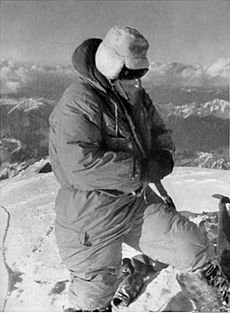
The first successful climb of K2 happened on July 31, 1954. It was an Italian expedition led by Ardito Desio. The two climbers who reached the summit were Lino Lacedelli and Achille Compagnoni. They used the Abruzzi Spur route. Other team members, including Walter Bonatti and Pakistani porter Amir Mehdi, helped carry oxygen tanks high up the mountain. This was crucial for the summit team's success.
Twenty-three years later, in 1977, a Japanese team made the second successful climb. Ashraf Aman became the first Pakistani climber to reach the summit. In 1978, an American team made the third ascent. They used a new route called the Northeast Ridge.
A notable Japanese climb happened in 1982 on the difficult North Ridge. Three climbers reached the summit. Sadly, one of them died on the way down. The first person to climb K2 twice was Czech climber Josef Rakoncaj. He reached the top in 1983 and again in 1986.
The first woman to summit K2 was Polish climber Wanda Rutkiewicz in 1986. Sadly, other women climbers who summitted later that day died on their descent. K2 has seen many tragedies. In 1986, 13 climbers died. In 1995, six died, and in 2008, 11 climbers lost their lives.
Recent Climbs and Achievements
- 2004: Carlos Soria Fontán from Spain became the oldest person to summit K2 at 65 years old.
- 2008: A large piece of ice fell, causing an avalanche. This led to the deaths of 11 climbers.
- 2011: Gerlinde Kaltenbrunner became the first woman to climb all 14 of the world's highest mountains (eight-thousanders) without extra oxygen. She summitted K2 from the North side.
- 2012: K2 saw a record number of climbers reach the summit in one day: 28 people.
- 2014: The first team of Pakistani climbers successfully scaled K2. Also, a team of three Nepali women became the first Nepali women to climb K2.
- 2017: Vanessa O'Brien became the first British and American woman to summit K2. She was 52, making her the oldest woman to achieve this.
- 2018: Garrett Madison became the first American to summit K2 more than once. Also, Polish mountaineer Andrzej Bargiel became the first person to ski all the way down from the summit to base camp.
- 2022: More than 100 climbers reached the summit of K2 in a single day. This was the highest number ever recorded for K2.
Winter Expeditions
Climbing K2 in winter is extremely difficult due to harsh conditions. Many attempts failed:
- 1987/1988: A Polish-Canadian-British team reached 7,300 metres (24,000 ft) but had to turn back due to hurricane-force winds.
- 2002/2003: A Polish team reached 7,650 metres (25,100 ft). Their final attempt failed when a tent was destroyed by bad weather.
- 2011/2012: A Russian team reached 7,200 metres (23,600 ft). They had to retreat after one climber died from frostbite and pneumonia.
- 2017/2018: A Polish team reached 7,400 metres (24,300 ft) on the Abruzzi Spur. One climber reported reaching 7,600 metres (24,900 ft) during a solo attempt.
- 2021: On January 16, 2021, a team of ten climbers from Nepal made history. They became the first to successfully climb K2 in winter. They all summitted together. Nirmal Purja was the only one who did not use extra oxygen. The temperature at the summit was −40 °C (−40 °F). Sadly, some climbers from other teams died during this expedition.
Climbing Routes and Challenges
K2 has several climbing routes. They all share major difficulties:
- Extreme Altitude: At the summit, there is only one-third as much oxygen as at sea level. This makes breathing very hard.
- Severe Storms: The mountain often has long, dangerous storms. These storms have caused many deaths.
- Steep and Exposed Routes: All paths on K2 are very steep and open to the elements. This makes it hard to retreat, especially during a storm.
Most major climbing routes are on the Pakistani side of the mountain. The main base camp is also located there.
Abruzzi Spur: The Main Route
The Abruzzi Spur is the most common way to climb K2. About 75% of all climbers use this route. It is on the southeast side of the mountain. The route starts at an Advanced Base Camp at 5,400 metres (17,700 ft).
Climbers face rock sections, ice fields, and technical rock climbing. Famous parts include "House's Chimney" and the "Black Pyramid." Above these, climbers reach the "Shoulder." The last big challenge is a narrow passage called the "Bottleneck." This part is very dangerous. It is close to a wall of ice cliffs. In 2008, 11 climbers died in this area due to ice falls.
North Ridge: A Tougher Path
The North Ridge is on the Chinese side of K2. It is climbed much less often. Getting to it is very difficult, as it involves crossing a dangerous river. This route is technically harder than the Abruzzi Spur. It goes up a long, steep rock ridge. Climbers then cross a risky hanging glacier to reach the summit.
Other Routes and Unclimbed Faces
Because the Abruzzi Spur is so popular, other routes are rarely used. No one has ever climbed the East Face of K2. This is because the snow and ice there are very unstable. The North Face has also not been climbed yet.
Using Extra Oxygen
For many years, climbers on K2 usually did not use extra oxygen. Teams were often small and light. However, in 2004, more climbers started using oxygen. That year, 28 out of 47 climbers who reached the summit used it.
Climbing without oxygen requires your body to get used to the high altitude. This helps avoid altitude sickness. Above 8,000 metres (26,000 ft), climbers enter the "death zone." In this zone, the body starts to shut down because there isn't enough oxygen.
Films About K2
K2's challenging nature has inspired several films:
- K2 (1991): An adventure drama based on the story of the first Americans to summit K2.
- Vertical Limit (2000): An American survival thriller film.
- K2: Siren of the Himalayas (2012): A documentary following climbers attempting K2 in 2009.
- The Summit (2012): A documentary about the 2008 K2 disaster.
- K2: The Impossible Descent (2020): A documentary about Andrzej Bargiel's historic ski descent of K2 in 2018.
Mountain Passes Near K2
Windy Gap is a high mountain pass located east of K2. It is 6,111-meter (20,049 ft) (about 20,049 feet) high. It sits north of Broad Peak and south of Skyang Kangri.
Images for kids
See also
 In Spanish: K2 para niños
In Spanish: K2 para niños


